INTRODUCTION
It is a fact that historical films are becoming increasingly important in shaping the way the past is understood and remembered. Although many critics have questioned the adequacy of this medium for the study of history, it will be a mistake for historians to ignore the importance of historical film in historical inquiry. More specifically, films about war played a significant role in how wars are remembered. Over the years, Hollywood has produced many films that are either directly about or set against the backdrop of the Vietnam War. However, very few Americans seem to be aware that the Vietnamese film industry has also produced a large number of films about the war. The different representations of the Vietnam War by filmmakers from the U.S. and Vietnam raise many interesting historiographical questions. This is a comparative study of how Vietnamese and American films have constructed the images of the war on the screen between 1979 and 2005.
The study of the Vietnam War has been suffered from the absence of a global perspective and insufficient knowledge of Vietnamese history. Many studies of the Vietnam War to date are dominated by Americans’ centric perspectives. My study calls for greater attention to the Vietnamese experience and history and the need for international dimension in the studies of the Vietnam War. Much academic research has surrounded the discussion on Hollywood films and its representation of the Vietnam War in retrospect of understanding the reaction of the American public and collective memory of the war. There is a distinct lack of attention towards the examination of the Vietnam film productions on this subject in which make the historical study and film analysis of the Vietnam War on films become a Western-centrical perspective. The purpose of studying Vietnam War films is not to explore the truth about the war or to question the U.S. government’s policy toward Vietnam. Instead, it is about analyzing how filmmakers have reconstructed the Vietnam War in films and how their reconstructions have been colored by changes in historical context. This research also includes popular Vietnamese films about the war against the Americans to solidify and broaden the discussion of Vietnam as represented in popular cinema worldwide.
The timeline provides a historical context for an overview of world history related to events in Vietnamese history in the nineteenth century to the twentieth century. It also illustrates how the war narrative in films changes due to the period of that time. The cinematic reconstruction of the Vietnam War will give a new perspective on the study of the Vietnam War.
•Blue: United States | •Red: Vietnam | •Green: World events
TIMELINE
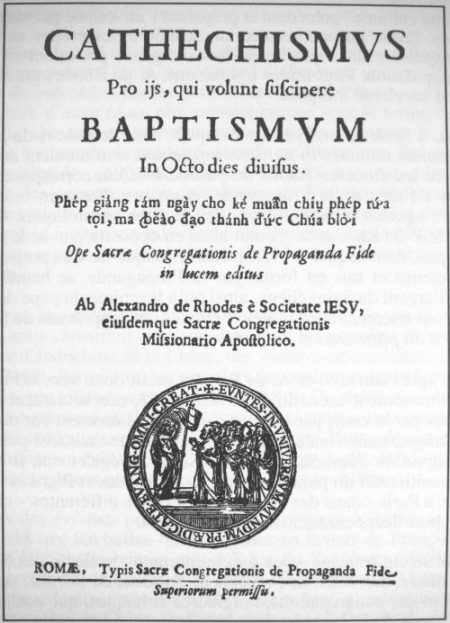
Vietnam: Event of Europeans and Southward expansion
1516: Portuguese arrival and other European traders and missionaries.
1651: Alexandre de Rhodes was a French Jesuit missionary, who wrote the Dictionarium Annamiticum Lusitanum et Latinum, the first trilingual Vietnamese-Portuguese-Latin dictionary published in Rome. Later, this writing system was defined as the modern Vietnamese language, known as quốc ngữ.
1887: The French established the Indochinese Union, made up of Annam, Cambodia, Cochin China, and Tonkin. Laos was added to the Union in 1893. Tonkin, Annam and Cochin China constituted the territory known previously as Vietnam.
World War I (1914 - 1918)
The United States entered the war on April 7, 1917.
During the outbreak of World War I, while attempting to increase the use of Indochina's resources and manpower to fight the WWI, France suppressed all patriotic gatherings in Vietnam. Approximately 100,000 Vietnamese went to Europe to fight and serve on the French battlefront. Those, who survived the war, exposed to new political ideas and returning to Vietnam with a determination on overthrowing the French.
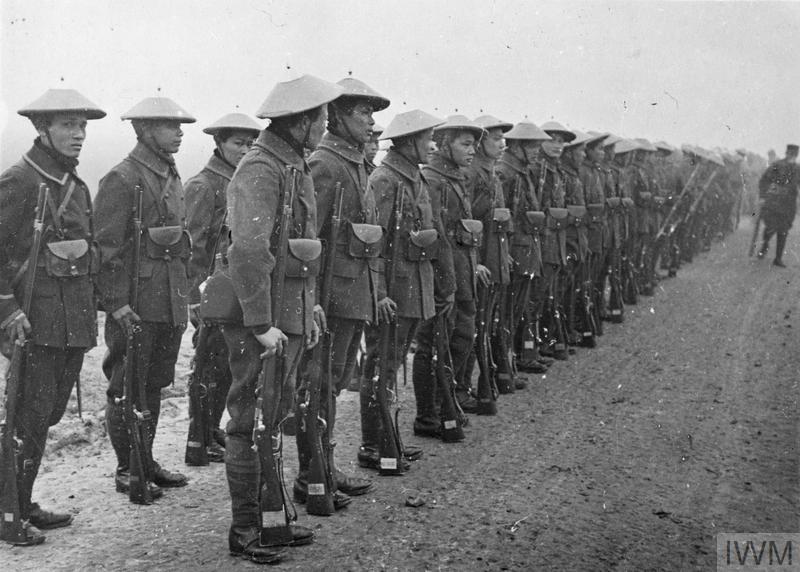
Vietnam
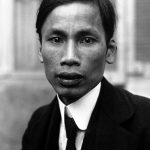
1920: Ho Chi Minh (or Nguyen Ai Quoc) participated in the eighteenth century Congress of the Socialist Party of France, voted in favor of joining the Third International becoming the first of the French Communist Party.
1921: Nguyen Ai Quoc participated in the founding the Colonial Union in France.
U.S: 1930s
The combination of the Great Depression and the World War II happening in Europe had many Americans people favor Isolationism. American people believed that the U.S. should not intervene with any foreign affairs across the Atlantic world.
1933 – 1937: The New Deal
American Isolationism ideal went back to World War I. Immediately following the end of the First World War, Congress rejected U.S. membership in the League of Nations that was proposed by President Woodrow Wilson. Many Congressmen opposed membership in the League out of concern that it would draw the United States into European conflicts.
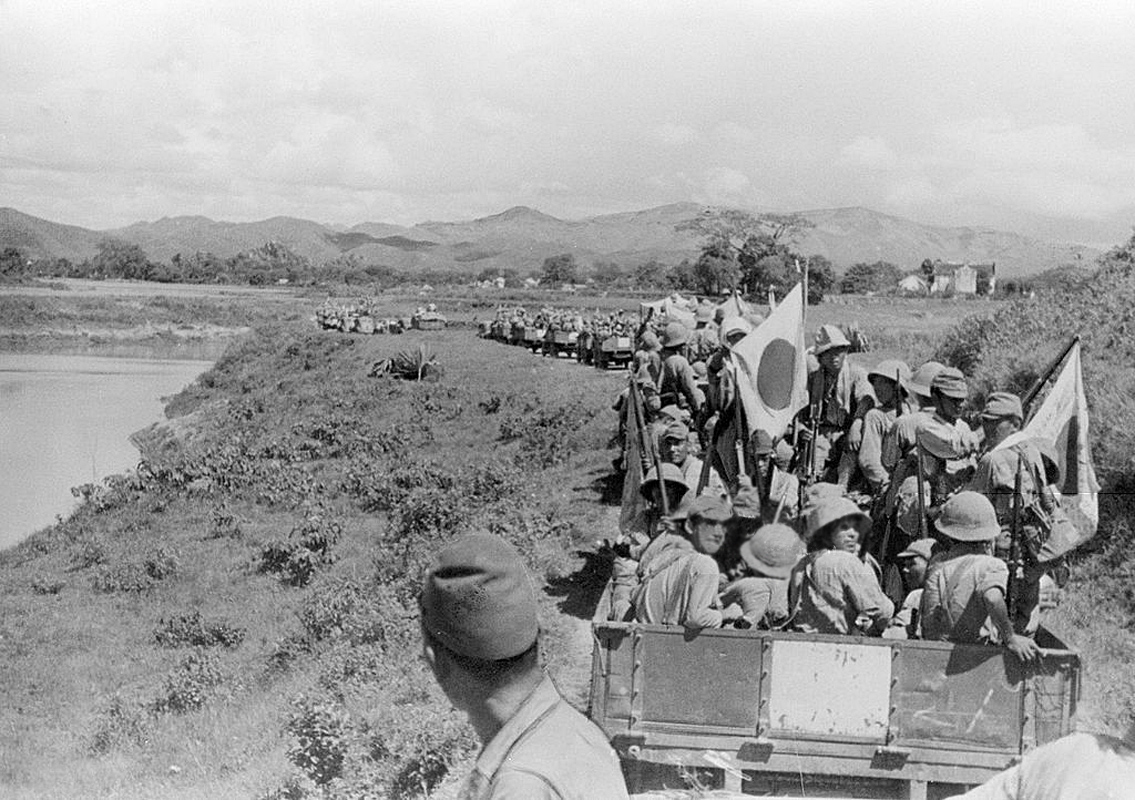
US: 1941
December 7: A surprise military strike by the Imperial Japanese Navy Air Service against the United States naval base at Pearl Harbor, Hawaii Territory – the attack is known as the Battle of Pearl Harbor.
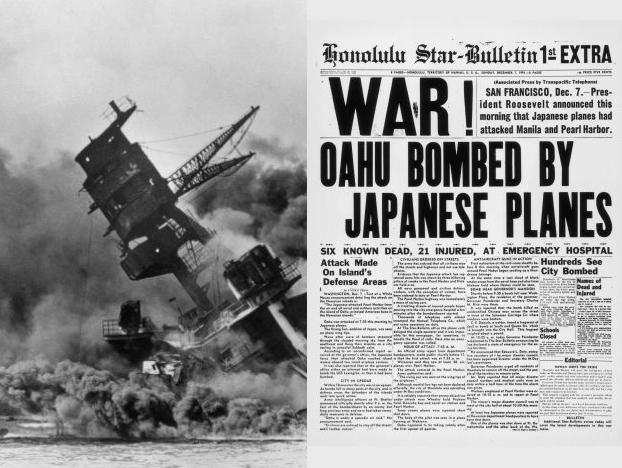
The attack triggered the patriotism and nationalism of the American public, which gave the U.S. government a justification to use military force to involve in the world conflicts.
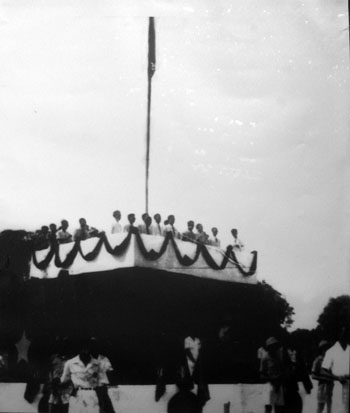
Vietnam: 1945
March: Removal of French power in Indochina.
August 15: the Japanese surrender to the Allies.
August 19: The Viet Minh seized power known as the August Revolution.
September 2: Ho Chi Minh announced the Proclamation of Independence of the Democratic Republic of Vietnam at the Ba Dinh Square.
September 23: The French officially returned to South Vietnam, beginning the second invasion of Vietnam, First Indochina War.
(In the following weeks, British, Chinese Nationalist, French and Indian troops entered Vietnam, and despite Vietnam Minh resistance, the French were re-installed as colonial rulers)
1949
August: The Soviet Union exploded its first atom bomb in a remote area of Kazakhstan, marking a tense turning point in the Cold War with the United States.
October: Following a civil war, Chinese Communist leader Mao Zedong declared the creation of the People’s Republic of China.
Fears about the activities of Communists in America, which Senator McCarthy would take advantage of in subsequent years, were sharpened by accusations that Alger Hiss, a former employee of the State Department, had passed secrets to the Soviet Union.
U.S: March 1949
In an address to Congress, President Harry Truman stated that the foreign policy of the United States is to assist any country whose stability is threatened by communism. The policy is known as the Truman Doctrine.
Vietnam: 1950
January: Democratic Republic of Vietnam was recognized by China and USSR.
March: Truman agreed to provide military assistance to the French in Indochina.
June 25: The war broke out in Korea, America accelerated its provision of military and economic assistance to the French.
December: Napalm bombs were first used in Vietnam against the Viet Minh in Tien Yen
US: 1953
January: Under President Eisenhower, an armistice was signed in July to end the Korean War (1950 – 1953)

←Territory often changed hands early in the war, until the front stabilized | Source: Wikipedia
• North Korean, Chinese, and Soviet forces
• South Korean, U.S., Commonwealth, and United Nations forces
March: Eisenhower continued Truman’s policy of assisting the French in Indochina, agreeing an additional 385 million dollars of aid in September.
During the Korean War, 33,629 U.S troops, about 3,000 UN troops, about 50,000 South Koreans, and an estimated 1.5 million Communists from China and North Korea died.
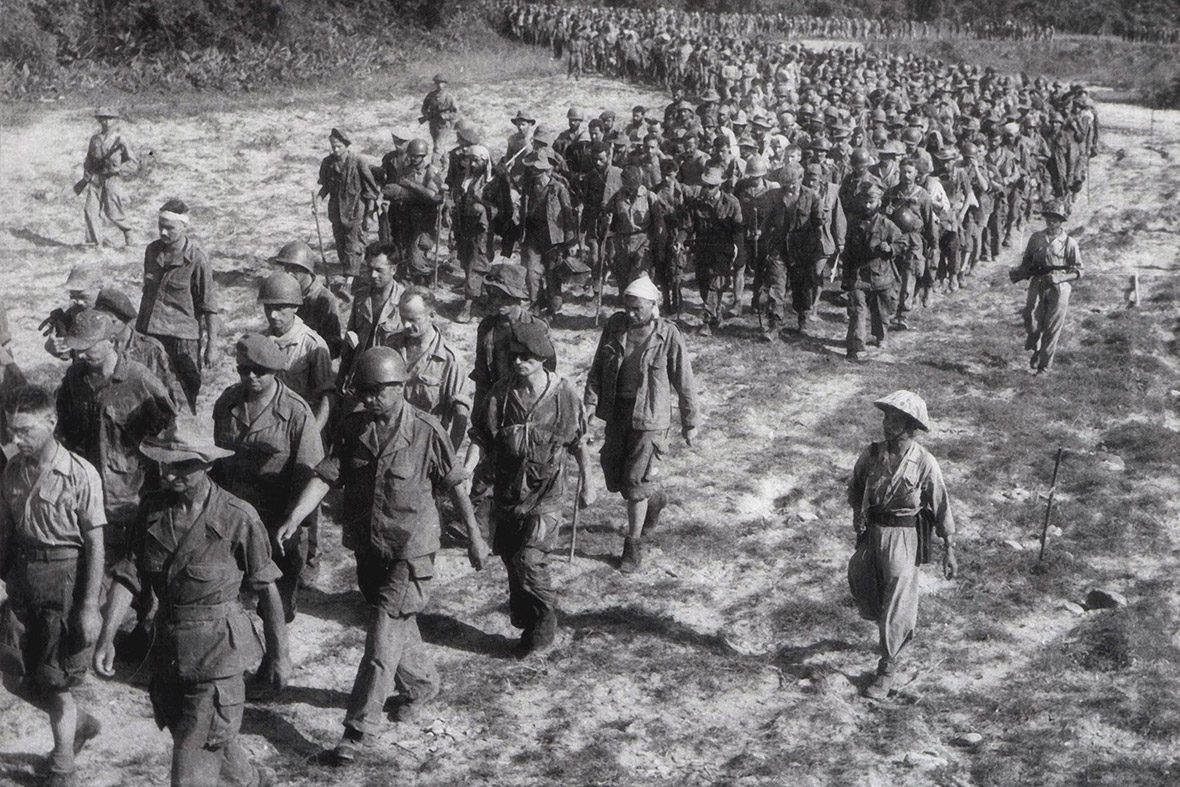
Vietnam: 1954
March-May: French troops were humiliated in defeat by Viet Minh forces at Dien Bien Phu. The attempt to take the outpost lasts 2 months, during which time the French government agreed to peace talks in Geneva. The defeat solidifies the end of French rule in Indochina.
July: Ngo Dinh Diem was appointed by the U.S. government and became the President of South Vietnam.
1954
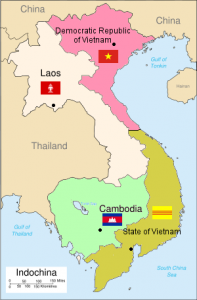
Geneva Conference of 1954 – the agreement was finalized on July 21, 1954. The Vietnamese Demilitarized Zone established a dividing line between North and South Vietnam as a result of the First Indochina War (1946 – 1954). It was nominally described at “the 17th parallel.”
Vietnam: 1956
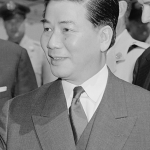 Ngo Dinh Diem – 1st President of the Republic of Vietnam begins his campaign against political dissidents. After becoming president, he retained all the rights to govern South Vietnam with his brother Ngo Dinh Nhu as an advisor, and both made aggressive policies against the Viet Minh’s supporters. He was a leader of the Catholic element and was opposed by Buddhists, which later on led to many religious and political conflicts against Southern Vietnamese.
Ngo Dinh Diem – 1st President of the Republic of Vietnam begins his campaign against political dissidents. After becoming president, he retained all the rights to govern South Vietnam with his brother Ngo Dinh Nhu as an advisor, and both made aggressive policies against the Viet Minh’s supporters. He was a leader of the Catholic element and was opposed by Buddhists, which later on led to many religious and political conflicts against Southern Vietnamese.
Vietnam: 1959
The North Vietnamese sent personnel and supplies into the South by land, along the Ho Chi Minh trail, and by sea. Two American military advisors were killed at Bien Hoa.
23 years later, their names would be the first of more than 58,000 inscribed on the Vietnam Veterans Memorial in Washington D.C.
US
1960: John F. Kennedy was elected to the presidency. On 20 December the formation of the National Liberation Front (referred to as the Viet Cong by the South Vietnamese government) was announced in Hanoi.
1961: President John F. Kennedy sent helicopters and 400 Green Berets to South Vietnam and authorizes secret operations against the Viet Cong.
On January 17, 1961, President Eisenhower's farewell address was best known for advocating the national defense force against the potential impact of the military-industrial complex.
German
August 13, 1961: The construction of the Berlin Wall begins by the Soviet bloc, segregating the German city.
Cuba
April 17, 1961: The Bay of Pigs invasion of Cuba is repulsed by Cuban forces in an attempt by Cuban exiles under the direction of the U.S. government to overthrow the regime of Fidel Castro.
October 14, 1962: The Cuban Missile Crises begins. In response to the Soviet Union building offensive missiles in Cuba, President John F. Kennedy orders a naval and air blockade of military equipment to the island. An agreement is eventually reached with Soviet Khrushchev on the removal of the missiles, ending the potential conflict after 38 days.
U.S: January 1962
In Operation Ranch Hand, U.S. aircraft start spraying Agent Orange and other herbicides over rural areas of South Vietnam to kill vegetation that would offer cover and food for guerrilla forces.
By 1961, the American military force grew from 900 to 3,200 and some took part in combat against NLF forces
U.S: 1963
July 25: The United States, Soviet Union, and Great Britain agree to a limited nuclear test-ban treaty, barring all nuclear testing above ground.
August 28: The Civil Rights march on Washington, D.C. for jobs and Freedom culminates with Dr. Martin Luther King’s famous “I Have a Dream” speech from the steps of the Lincoln Memorial. Over 200,000 people participated in the march for equal rights.
November 22: President John F. Kennedy is assassinated by Lee Harvey Oswald. Vice President Lyndon B. Johnson is sworn into office later that day.
At this time, the American force in South Vietnam was in excess of 16,000
Vietnam: 1963
January 2: South Vietnamese forces humiliate defeated in a battle at Ap Bac.
By the summer, Ngo Dinh Diem and his brother, Ngo Dinh Nhu, attempted to crush Buddhist activists and Diem’s failure to deliver reforms persuaded Kennedy that a change was needed.
December: the North Vietnamese agreed to provide NLF forces with Chinese and Soviet weaponry and additional personnel.
Vietnam: 1964
January 30: General Nguyen Khanh seized power in South Vietnam
August 2: North Vietnamese boats attacked an American destroyer in the Gulf of Tonkin. Reports of a second attack on August 4 led to the bombing of North Vietnam by American planes and a congressional resolution which enabled Johnson to ‘take all necessary measures … to prevent further aggression.’
The first North Vietnamese infantry regiments moved into South Vietnam where more than 23,000 Americans were serving
U.S: 1965
February 7: President Johnson orders the continuous bombing of North Vietnam below the 20th parallel.
March 25: Martin Luther King speaks at a civil rights rally on the courthouse steps of the Alabama State Capitol, ending the Selma to Montgomery, Alabama march for voting rights.
August 6: The Voting Rights Act of 1965 is signed into law by Johnson.
October 15: The first public burning of a draft card occurs in protest to the Vietnam War. It is coordinated by the antiwar group of students, National Coordinating Committee to End the War in Vietnam.
U.S: 1968
March 31: President Johnson announces a slowing to the bombing of North Vietnam, and that he would not seek reelection as president. Peace talks would begin May 10 in Paris; all bombing of North Korea halted October 31.
April 4: Assassination of Civil Rights leader Martin Luther King in Memphis, Tennessee.
June 5: Presidential candidate, Robert F. Kennedy, is shot at a campaign victory.
November 5: Richard M. Nixon won the presidential election.
U.S: Early 1970s
Watergate Scandal: President Nixon’s administration was under investigation for wiretapping phones and stealing documents that connected to Nixon’s reelection campaign.
U.S: December 1972
President Nixon orders the launch of the most intense air offense of the war in Operation Linebacker II. The attacks, concentrated between Hanoi and Haiphong, drop roughly 20,000 tons of bombs over densely populated regions.
Vietnam: 1975
Fall of Saigon: On April 30, 1975 the Liberation Front of South Vietnam (or the Viet Song) took control of the city while the American military began to flee out of the country calling for immediate evacuation.
Operation Frequent Wind (1975): the final phase of evacuation from the U.S. Army. Vietnamese high government official also got to go along with the Americans.
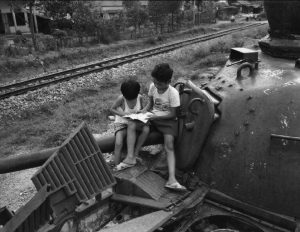
Vietnam
1978: Upon the establishment of the unified Socialist Republic of Vietnam, Saigon was renamed to Ho Chi Minh City.
1986: the Vietnam government initiated an economic reform known as ‘đổi mới’ (or doi moi) and adjusted its foreign policy to welcome investment from foreigners. From 1975 to 1985, the five-year plans on collectivization of agricultural and industrial production was a disappointment. It resulted in a severe economic crisis, causing scarcity of staples and consumer goods, impoverished living conditions, industrial stagnation, and mounting foreign debts. The government announced the economic reform plan, doi moi, in 1986, but there were many experimental policies before the official development took off in 1989.
1989: Vietnamese troops withdraw from Cambodia.
1992: New constitution adopted allowing certain freedoms. The Communist Party remains the leading force in Vietnamese society.
For a gallery of Vietnam in 1990s, click here.
U.S
1991: Gulf War
1994: U.S. lifts its 30-year trade embargo.
1995: Vietnam and the U.S restore full diplomatic relations. Vietnam becomes full member of the Association of Southeast Asian Nations –(ASEAN).
2000: U.S. President Bill Clinton pays a three-day official visit. The U.S. pledges more help to clear landmines left over from the Vietnam War. The Vietnamese government estimates nearly 40,000 people have been killed by unexploded munitions.
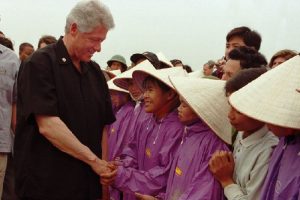
U.S: 2001
September 11: Terrorist attacks by Islamic terrorist group. Two planes were flown into the twin towers of the World Trade Center in New York City. This led to military intervention in the Middle East.
2001 Invasion of Afghanistan – Operation “Enduring Freedom”
2002: Department of Homeland Security created.
2003: Invasion of Iraq
